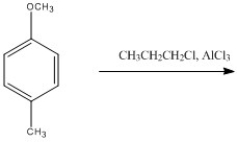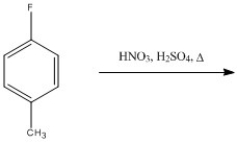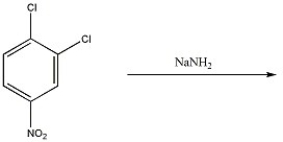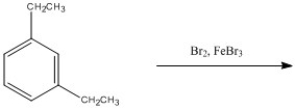A) 1 < 2 < 3
B) 2 < 3 < 1
C) 3 < 2 < 1
D) 2 < 1 < 3
E) 1 < 3 < 2
G) C) and E)
Correct Answer

verified
Correct Answer
verified
Essay
Show what reagents are needed to complete the transformation below. 
Correct Answer

verified
Correct Answer
verified
Essay
Provide the major organic product of the following reaction. 
Correct Answer

verified
Correct Answer
verified
Essay
Provide the structure of the major organic product of the following reaction. 
Correct Answer

verified
Correct Answer
verified
Essay
Draw the four major resonance structures of the sigma complex intermediate in the reaction of anisole with HNO3/H2SO4 to yield p-nitroanisole.
Correct Answer

verified
Correct Answer
verified
Essay
Provide the structure of the major mononitration product of the compound below. 
Correct Answer

verified
Correct Answer
verified
Essay
Provide the major organic product of the following reaction. 
Correct Answer

verified
Correct Answer
verified
Essay
Provide the structure of the major organic product in the following reaction 
Correct Answer

verified
Correct Answer
verified
Multiple Choice
Which of the following is an intermediate when 1,2-dibromo-4-nitrobenzene is heated with NaOH in a nucleophilic aromatic substitution reaction?
A) ![]()
B) ![]()
C) ![]()
D) ![]()
F) A) and B)
Correct Answer

verified
Correct Answer
verified
Essay
Provide the major organic product(s) of the reaction shown below. 
Correct Answer

verified
Correct Answer
verified
Essay
Provide the major organic product of the following reaction. 
Correct Answer

verified
Correct Answer
verified
Essay
Provide the major organic product of the following reaction. 
Correct Answer

verified
Correct Answer
verified
Essay
Draw a mechanism for the following reaction. 
Correct Answer

verified
Correct Answer
verified
Multiple Choice
In electrophilic aromatic substitution reactions a bromine substituent ________.
A) is a deactivator and a m-director
B) is a deactivator and an o,p-director
C) is an activator and a m-director
D) is an activator and an o,p-director
E) none of the above
G) None of the above
Correct Answer

verified
Correct Answer
verified
Essay
Provide a detailed, stepwise mechanism for the following reaction. 
Correct Answer

verified
Correct Answer
verified
Essay
Provide the structure of the major organic product in the following reaction. 
Correct Answer

verified
Correct Answer
verified
Multiple Choice
In electrophilic aromatic substitution reactions, a cyano substituent on the aromatic ring is ________.
A) a deactivator and a m-director
B) a deactivator and an o,p-director
C) an activator and a m-director
D) an activator and an o,p-director
E) none of the above
G) A) and C)
Correct Answer

verified
Correct Answer
verified
Essay
Provide the structure of the major organic product(s) in the following reaction. 
Correct Answer

verified
Correct Answer
verified
Essay
What aryl halide would you use in the Suzuki reaction to make the following product? 
Correct Answer

verified
Correct Answer
verified
Essay
Why are Friedel-Crafts acylation reactions not prone to polyacylation?
Correct Answer

verified
Once the ring is acylated, it ...View Answer
Show Answer
Correct Answer
verified
View Answer
Showing 21 - 40 of 129
Related Exams